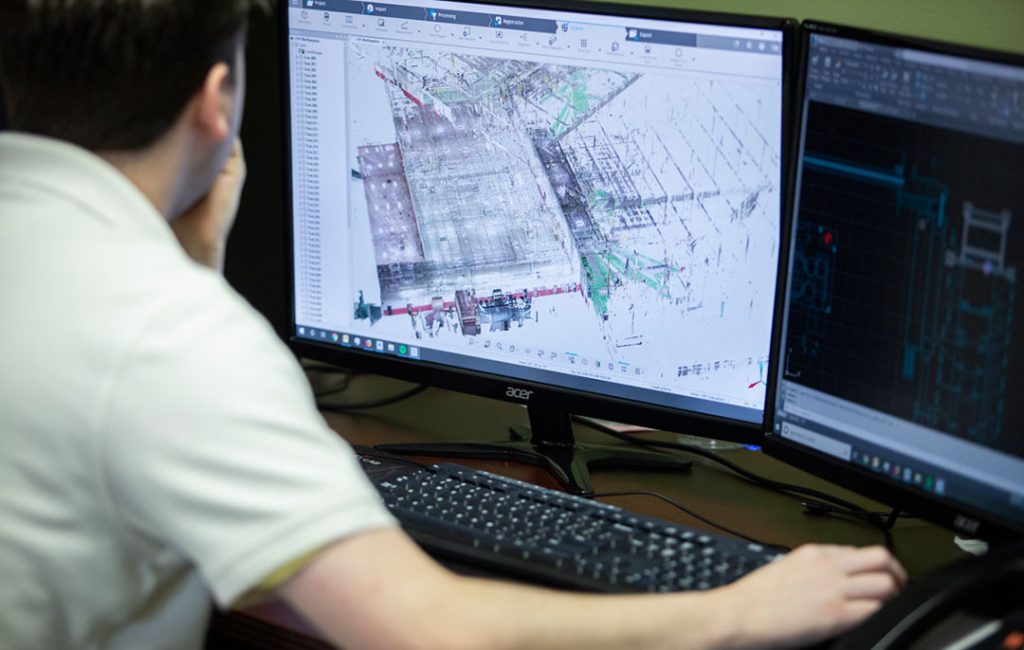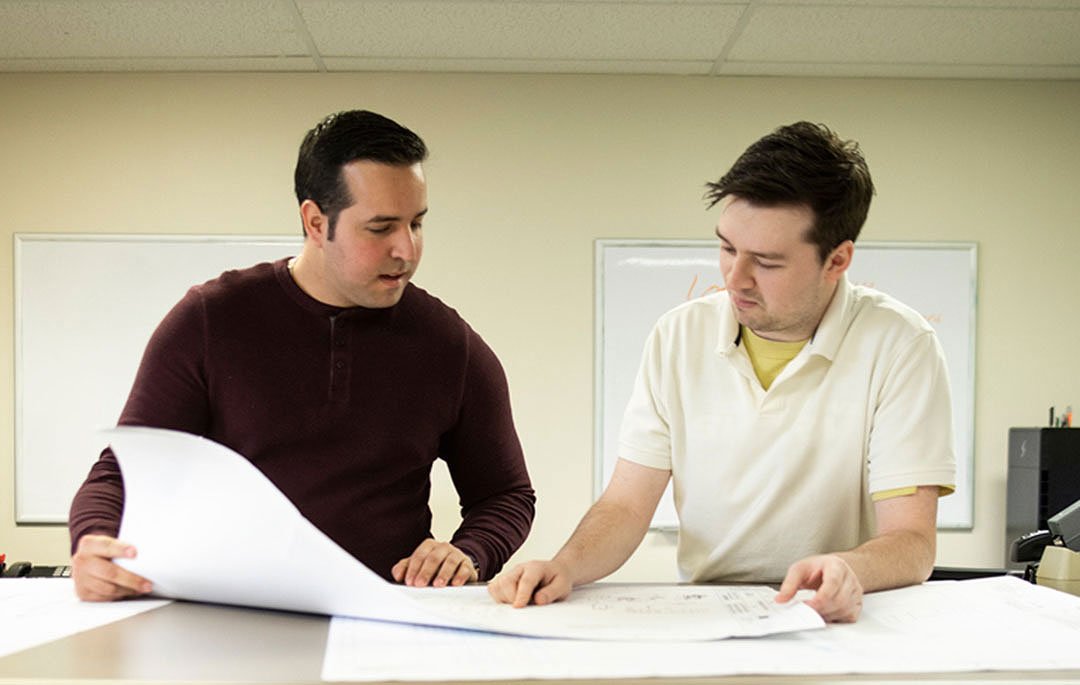Getting an accurate takeoff of any facility can be a challenge. We understand, and we can help. At InterTech, we work with manufacturers to optimize production line design for space and efficiency. We’re involved in every aspect of production and packaging from raw materials to finished product. In this article, we’d like to tell you about our FARO Focus S70 3D scanner, which can help you get an accurate takeoff of your existing structure. Our 3D scan provides incredible accuracy and detail up to 1 mm.
You already know the importance of an accurate takeoff before starting any new project. Without it, you won’t be able to properly estimate the costs, equipment and materials needed to successfully add on your new installation.
How to Get an Accurate Takeoff of an Existing Structure
There are two methods commonly used for putting together a takeoff. The first one is a manual process, which is the traditional, time consuming method. It involves looking at the original blueprints and schematics – and combining them with manual calculations across multiple complex spreadsheets.
Over time, if a door, wall or conveyor has been moved, increased manual measuring is required. Blueprints don’t usually include all of the fixtures in your plant, requiring even more manual measuring.
Since the process is completed by hand, there is room for expensive errors that often aren’t caught until after the new project begins. This method is often times not effective, especially when adding a new line or installation to your facility.
The second way to get an accurate takeoff of your existing structure is to use digital equipment that automates this important part of the process. InterTech can provide a 3D scan of your facility, which gives you the information you need to create an accurate takeoff – which leads to a more successful project without unexpected costs.
Recently I talked to InterTech’s Reinaldo Camacho and Zachary Clevenger about how these 3D scans and the maps they create provide value to their clients.

Diana Adams: Your FARO Focus S70 3D scanner uses laser imaging to scan the surrounding area in an existing structure. Can you explain how that is beneficial to your clients who want an accurate takeoff?
Reinaldo Camacho: Imagine how difficult it is to get an accurate measurement of any manufacturing plant – especially a large one. Measuring manually is labor intensive and time consuming, plus it doesn’t provide the level of accuracy needed for efficient and cost-saving plant modifications. Most takeoffs only focus on the larger piping and rarely capture other items like light fixtures, low voltage electrical conduits, sprinkler systems, etc.
Since our 3D scanner is portable, we can visit a plant one time and take a series of scans over a day or two, which are then used to produce a 3D plant map with incomparable accuracy. It captures all items within the area of scanning and locates all piping, electrical conduit or tray, sprinkler system and fixtures exactly where they are.
Diana Adams: What happens after you take the scans? What’s the next step of the process?
Zachary Clevenger: When we get back to our offices, we upload the files from the scanner into our computers. We use a proprietary software to piece together all the scans, which is when we create an overall 3D map of the entire manufacturing plant.
In InterTech’s CAD department, we can also import the scans into our AutoCAD software. This allows us to manipulate them into our 3D designer software. We can then see the exact position of everything in the manufacturing plant, with an accuracy of up to 1 millimeter.
Reinaldo Camacho: Exactly, and with our 3D design software, we can position new equipment or pipes, or increase operational efficiency by suggesting the relocation of existing equipment. In other words, if the equipment is feasible in the software, we know with confidence that it will be feasible in the physical space. We can avoid interferences and problems before they even get to the construction phase.
Diana Adams: Can you tell me about an experience you’ve had when the 3D map you created gave your client new information for their takeoff?
Zachary Clevenger: Although this scan is useful for any plant manager to have on hand, it’s especially useful for existing plants that want to add onto their systems.
With the help of our 3D scanner, we can show our clients exactly where everything is located. For example, without this scan, they might only be able to use the 2D drawings from the architect or other engineering firms. However, after those drawings were produced, the actual installation may have changes that were undocumented, like moved a conveyor or a wall 6 inches.
Recently, we experienced both of these scenarios upon completion of a scan. This kind of detailed information would remain unknown unless you had your facility scanned and compared to the original drawings.
Not long ago, we were completing a project where the drawings showed the roof deck to be located at 34 feet. The equipment our client wanted to install was 33 feet, 2 inches tall. With the clearance required for the cap removal, we actually needed a clear height of 33 feet and 6 inches.
We visited the site and completed a scan of the work area. When we completed the scan and located the roof cross members and the sprinkler system, we were able to strategically place the equipment to avoid all hindrances.
We realized that the previous location of the equipment would not have worked and we were able to redesign and properly locate the necessary foundation pad. They were able to avoid costly changes by opting for a scan of their plant before finalizing the bid documents.
In my opinion, this scan is a crucial step when adapting new installations to existing structures. For example, this scan would be helpful when trying to determine overhead clearance or possible interference with piping and other items.
Greg Kershner, President of InterTech, also had an experience recently that speaks to the benefits of getting your facility scanned:
“I never used to be into the 3D scanner, but we just completed a large complicated retro-fit project where we probably went through 18 iterations of the drawings overlaying the electrical, structural and mechanical aspects. We resolved major issues that would have been very costly and time consuming to resolve in the field. That project sold me on the 3D scan.”

Diana Adams: It sounds like this 3D scan provides another layer of useful data. Can you give me another example of how this can provide value to your clients and save them money?
Reinaldo Camacho: There’s definitely a cost savings associated with getting a detailed, 3D scan of your manufacturing plant. You’ll know for sure what the dimensions of the space are in order to design the production line and place the equipment accurately. Without this scan, or many days or weeks creating detailed drawings, changes in the field can be common and costly.
And, the cost savings go beyond just being sure the new equipment will fit and perform optimally. This 3D representation of your plant reduces the likelihood of errors from contractors. They can follow our 3D model, which is extremely accurate. This avoids change orders, modifications to steel work and building structure, etc.
According to the FARO website: The ultra-portable Focus S70 enables fast, straightforward and ultra-high accurate measurements of objects and buildings. It records architectural facades, complex structures, production and supply facilities, accident sites, and large-volume components delivering realistic and true-to-detail scan results with a range of 70m per scan.
Would you like us to create a 3D map of your plant? Give InterTech a call at 770-431-5959. Let us help you get an accurate takeoff of your facility so you can take your business to the next level.

For over 35 years, InterTech has helped hundreds of food and beverage plants implement a variety of manufacturing projects. Whether it be a single line or multi-plant roll out, we have helped reduce their operating costs by $2-10 million per year.
Let us model your operations and show you the feasibility of your project ideas. The earlier we get involved, the more money we can help you save.
For multi-plant clients, we have helped develop long-term plans to capitalize on the savings of initial projects in order to support future projects whose returns are lower.
We also develop Requests for Information (RFIs) or Requests for Proposals (RFPs) for major equipment so our clients can be assured they are getting the correct equipment at the best value. By assembling all of the information we receive into a Total Cost of Ownership, we can forecast operational costs for the long-term and establish budgets for plants that have not previously been self-manufacturing their bottles.
Our clients include Cargill, AAK, Constellation, Ghirardelli, and both Coca Cola and Pepsi Cola (and their respective bottlers) and many others. We invite you to view a more complete list of our esteemed past and current clients.
Working with InterTech-s experienced engineering staff will help you make informed decisions and avoid costly changes.
InterTech
120 Interstate North Parkway SE
Suite 102
Atlanta, GA 30339
770-431-5959


thank you